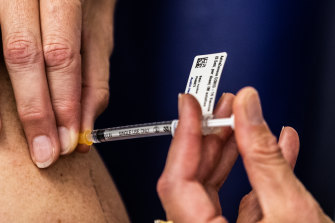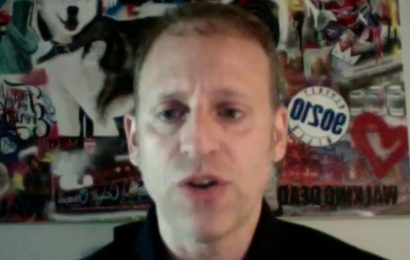Making sure the coronavirus vaccine is rolled out to whoever needs it is a manufacturing and logistical exercise of a scale never before attempted. With a world population heading for 8 billion, a virus cutting a swath through dozens of countries, and most vaccines requiring two doses, it is no surprise that every nation is scrambling to secure sufficient supply. Some are doing better than others.
Israel leads the pack. It has already vaccinated close to 50 per cent of its population with jabs from Pfizer after it agreed to share extensive medical data with the pharmaceutical giant. In sheer volume, America is ahead, having given more than 110 million people at least one dose and, after a slow start, it is managing to vaccinate nearly 2.5 million people a day.
Victorian GPs were swamped with calls from people wanting to book in their COVID-19 vaccine.Credit:Getty Images
But there are plenty of countries, including Australia, that have got off to a slow start. Only five with a population of more than 1 million have managed to vaccinate 10 per cent of their population or more.
The urgency of the situation has not abated. While the global number of new daily infections has dropped since the high in mid-January, there are still almost half a million people testing positive each day, mostly in Europe, the Americas and India. But even in nations that have low infection rates, such as Australia, there is a growing realisation that unless a sizeable proportion of the global population is vaccinated, there will be little chance of reopening borders and returning life to some form of normality.
The desperate pursuit of these life-saving inoculations has led to a flurry of vaccine diplomacy. Both Russia and China have committed to providing hundreds of millions of doses to a range of developing nations in exchange for stronger ties. Since taking over as US President, Joe Biden has attempted to counter this by contributing billions of dollars to the COVAX fund that was established to help developing nations obtain enough vaccine.
But that has not stopped some nations playing hardball. The European Union has been in fierce dispute with vaccine manufacturer AstraZeneca after the company was able to deliver only a third of the 90 million doses it promised during the first three months of the year. That dispute triggered the decision by the EU to ban a shipment of 250,000 AstraZeneca doses to Australia earlier this month.
Australia is hoping that 3.8 million of the 53.8 million AstraZeneca doses to be distributed here will be manufactured overseas, with the rest being made at CSL’s facility in Melbourne. But the global uncertainty has added to growing concerns that the local vaccination rollout is behind schedule and showing signs of serious teething problems.
On Wednesday, federal Health Minister Greg Hunt was forced to defend the government’s online booking system after it led to a flood of calls to clinics around the country from people trying to get the vaccine.
From Monday, about 1000 general practices are meant to start delivering vaccinations, alongside 100 Commonwealth-run, GP-led clinics. But along with hiccups in the booking system there has been uncertainly about the number of doses each clinic will get its hands on, a remarkable gaffe considering how many months of planning has gone into the rollout.
Despite the local mishaps and global jockeying for doses, we should not lose sight of the incredible progress that has been made.
It is only just over a year since China publicly released the first genomic sequencing of the coronavirus, the essential building block in developing a vaccine. Since then not only have several vaccines been approved, but close to 400 million doses have been administered. Whatever the glitches along the way, that has been a remarkable effort.
Note from the Editor
The Age’s editor, Gay Alcorn, writes an exclusive newsletter for subscribers on the week’s most important stories and issues. Sign up here to receive it every Friday.
Most Viewed in National
From our partners
Source: Read Full Article








